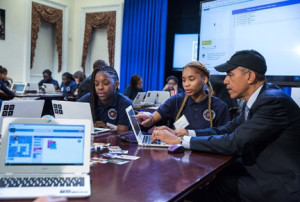Cecilia Muñoz & Megan Smith
The White House Blog, Here is what you can do to advance Computer Science Education.
Technology plays a role in nearly every aspect of our lives today —it’s how we connect with friends and family, discover the weather forecast, find jobs, play, and importantly learn. Yet too few of us, from our youngest to our eldest Americans, are going beyond being a ‘user’ of technology to becoming a maker, coder, discoverer, tinkerer, designer —and harnessing the power of computing to solve new challenges and make everyones’ lives healthier, safer, more efficient, better informed, and more fun.
Computational literacy” —being able to code, script, design, program, debug, and understand computer science—is rapidly emerging as an essential skill for today’s students. Many jobs in the 21st century will require the type of problem-solving ability that is advanced by training in computer science. In fact, it is projected that by 2020 information technology (IT) skills and computational thinking will be needed in more than half of all jobs and greater than 50 percent of the science, technology, engineering, and mathematics (STEM) job growth over that time period will be in computer science fields, leading to a shortage of more than one million IT-skilled Americans. In addition to IT professionals, people employed in most STEM jobs in the coming decades will require some level of sophisticated computational skills and many jobs inthe 21st Century will require the type of problem-solving ability that is advanced by computational thinking.
For those already in the workforce, the President’s TechHire Initiative and the Administration’s focus on inclusive entrepreneurship (including as part of the first-ever White House Demo Day) are aimed at providing more Americans with the skills today to launch careers in fields like cybersecurity, network administration, coding, project management, UI design and data analytics—positions with average salaries more than one and a half times higher than the average private-sector American job.
It’s time to ramp up our efforts to engage the next generation in these growing opportunities. Other countries have recognized the demand for a computational literate workforce and several, notably England, and are moving to offer computer science to all students, starting in early elementary school. However, in the United States, only 26 states allow students to count computer science toward high school graduation. In most U.S. schools, computer science is offered as an elective or not available at all.
Beyond access to computer science education more broadly, we as a country are also missing out on the talent and innovation from a large proportion of women and racial and ethnic minorities who are grossly underrepresented in IT and computer science fields. In 2015, girls represented only 22 percent and underrepresented minorities only 13 percent of the approximately 50,000 students who took the Advanced Placement Computer Science (AP-CS) exam nationally. In 10 states fewer than 10 high school girls took AP-CS—in 23 states, fewer than 10 African American students took the AP-CS, with none taking it in nine of those states. Unconscious and institutional bias keeps the U.S. from fielding all of our talent in these roles.
However, there is emerging good news—momentum is building to provide wider access for students to computational skills, computer science education and next generation ways of learning and teaching.
For example, in response to the President’s call to action ahead of CS Ed Week 2014, in December we announced:
•Commitments in partnership with Code.org by more than 60 school districts, including the seven largest in the country, to offer computer science courses.
•More than $20 million in philanthropic contributions to train 25,000 teachers to teach computer science in time for the 2016 school year.
•New partnerships with the National Science Foundation (NSF), including a new AP Computer Science course by the College Board, that emphasize the creative aspects of computing and a focus on real-world applications.
•New steps to increase the participation of women and people of color in computer science including many innovative outreach efforts.
•In September, NYC Mayor Bill de Blasio announced that within 10 years the city’s public schools will be required to offer computer science to all students. With this announcement, NYC joins Chicago, San Francisco, and other cities and districts with plans in place to offer computer science courses to all students in K-12 public schools.
•Parents overwhelmingly support these moves. According to a recent survey, a full nine out of ten parents support the use of class time for computer science education
•And last month, Congress passed and the President signed the STEM Education Act of 2015that specifically defines STEM to include computer science at a number of Federal agencies.
To build on this momentum — and in advance of Computer Science Education Week 2015 (December 7-13) — we are reissuing the call to public and private sector partners from districts across the country to commit to doing more to provide students with access to computer science and we want to hear about remarkable computer science educators and students in your community!
As you celebrate Computer Science Education Week, think about new commitments andremarkable CS champions and submit your ideas!
Cecilia Muñoz is Assistant to the President and Director of the Domestic Policy Council and Megan Smith is U.S. Chief Technology Officer.






